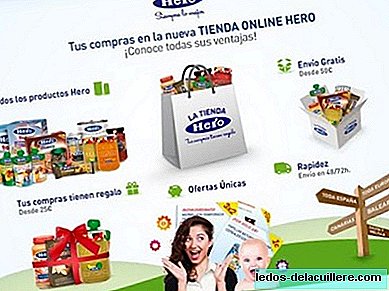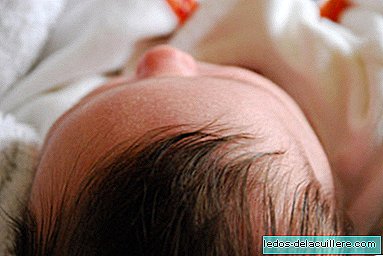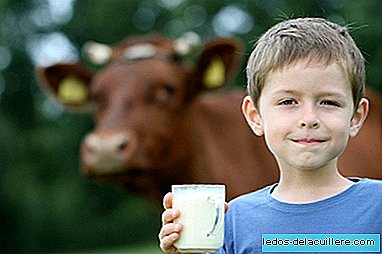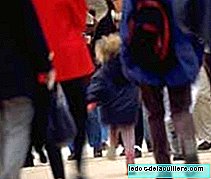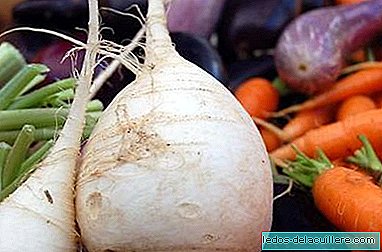
About to conclude our review of vegetables in child feeding, we focus on some of the Recommended foods from 12 months: spinach, chard, beet and turnip.
These vegetables are among those that accumulate greater amounts of nitrates, a substance that in itself is relatively little toxic, but that becomes toxic when it becomes nitrite.
Nitrate can be transformed into nitrite by bacterial reduction both in food (during irrigation, growth, processing and storage), as well as in the body itself (in saliva and gastrointestinal tract).
Vegetables with a high tendency to accumulate nitrites, such as those with green leaves and roots just listed, should be postponed in the baby's diet until after he is one year old.
A high dose of nitrates or nitrites is needed to produce acute poisoning to adult animals or humans, but in children and especially in young babies, minimal amounts are enough to trigger serious disorders.
This is because the nitrites in the blood oxidize the iron of hemoglobin producing methemoglobinemia, unable to transport oxygen, very common in babies (known as “blue baby syndrome” since respiratory difficulties cause the baby's lips to acquire that tonality).
In the first months of life, the baby's stomach still does not produce a large amount of acid, which favors the settlement of bacteria in the intestine that can ingest nitrates directly ingested nitrites.
On the other hand, nitrates react with the amino acids of food in the stomach, producing substances that have been shown to have carcinogenic effects.
Therefore, for the first baby porridge, after six months, it is best to introduce vegetables and vegetables with a tendency to accumulate less nitrates, which we have been talking about so far.
However, after 12 months and later, when the child's digestive system matures and when it grows, vegetables such as spinach, cabbage, cabbage, beets, chard, turnip, asparagus ... will provide them with beneficial nutrients and fiber.

Spinach and chard in infant feeding
Although the first two vegetables belong to the same family and are very similar in color, taste and shape, they provide different nutrients. Spinach leaves, comparatively, bring greater benefits to the body, more vitamins and minerals.
If we compare both cooked vegetables, at a weight of 100 grams. We can appreciate that spinach contribute 2.97 grs. of proteins, 2.4 grs. fiber, 136 mg. of calcium, 3.57 mg. of iron, 87 mg. of magnesium, 56 mg. phosphorus, 466 mg. of potassium, against 1.68 grs. of proteins, 2 grs. fiber, 16 mg. of calcium, 0.79 mg. of iron, 23 mg. of magnesium, 38 mg. of phosphorus and 305 mg. of potassium provided by chard.
Spinach and chard provide vitamins A, C and E, but in all of them the amount of the former is much greater, especially with respect to vitamin A.
They should be served cooked. As a recommendation when introducing these vegetables in the child's dishes, I would say that they drain well (the cooking water accumulates the nitrites) and that they are served in combination with other foods, as a complement (rice, egg, potatoes, legumes ... ).
Spinach naturally contains an organic acid (oxalic acid) that in large quantities favors the formation of kidney stones. It is a myth that contain so much iron, lentils or chickpeas for example have more.
The trunks of the chard are filamentous, so it is convenient to chop them well or discard them for younger children.
The beet in the infantile feeding
Beets belong to the same family as chard, although, unlike these, it is cultivated for its edible root and not for its leaves. In fact, beets are also known as "chard", "white chard" or "red chard". Other names that this vegetable receives are: betarava, betarraga, beterava, beterraga, beterrada (Canary Islands) and beet (Mexico).
The table variety is thick, red and fleshy roots, which are consumed mainly cooked; The color is due to two pigments, betacyanin and betaxanthin, which are indigestible, stain the bolus, feces and urine of that color. However, due to its atoxicity it is frequently used as a dye in food products.
It is a very energetic vegetable that is highly recommended for older people in cases of anemia, blood diseases and convalescence due to its high iron content, it is also rich in sugars, vitamins C and B, potassium and carotenes. The sugar contained in beets is sucrose.
It can be eaten in salads or cooked, but it keeps the properties better when it is raw, ideal for older children. If we cook it, it is better to remove the skin. Packaged beet is less advisable, as it has lost much of its properties and preservatives and other additives are added.
Although it is from a family other than turnip, which we will comment on, sometimes to beets, because of the similarity of the bulb, it is known as "red turnip" or "red turnip".
Turnip in infant feeding
The turnip is a Brassicaceae Commonly grown as a vegetable in temperate climates around the world for its bulbous root. The tender varieties are used for human consumption, although as we have pointed out, due to its accumulation of nitrates it is not convenient to introduce them into the baby's diet until after the year.
The most common variety of turnip marketed as a vegetable in Europe and North America is mainly skin and white meat, except for the part that protrudes from the earth (purple, red or greenish).
Turnip is a vegetable with low caloric intake because it has an abundant amount of water and a low carbohydrate content and is a good source of fiber. It provides an appreciable amount of vitamin C and folates, and discrete amounts of B vitamins (B6, B3, B1 and B2). On the other hand, it lacks provitamin A and vitamin E, abundant in other vegetables.
As for its composition in minerals, the most abundant is potassium, followed by calcium, phosphorus and iodine. The calcium of these roots is not assimilated just in relation to dairy products and other foods rich in this mineral.
To cook the turnip it is better to peel it. As we indicated in the case of carrots, if we cook it, it is better to do it separately and discard the water, where nitrates will have accumulated.
Some large varieties of turnips can have many filaments, so it is not convenient to give the child too large pieces.
Following all these tips we will achieve that Vegetables such as chard and spinach, beets and turnips begin to be part of children's nutrition in a healthy way. As we are located from the year of age, the consumption of these vegetables can be done in small pieces, better than crushed in porridge.


